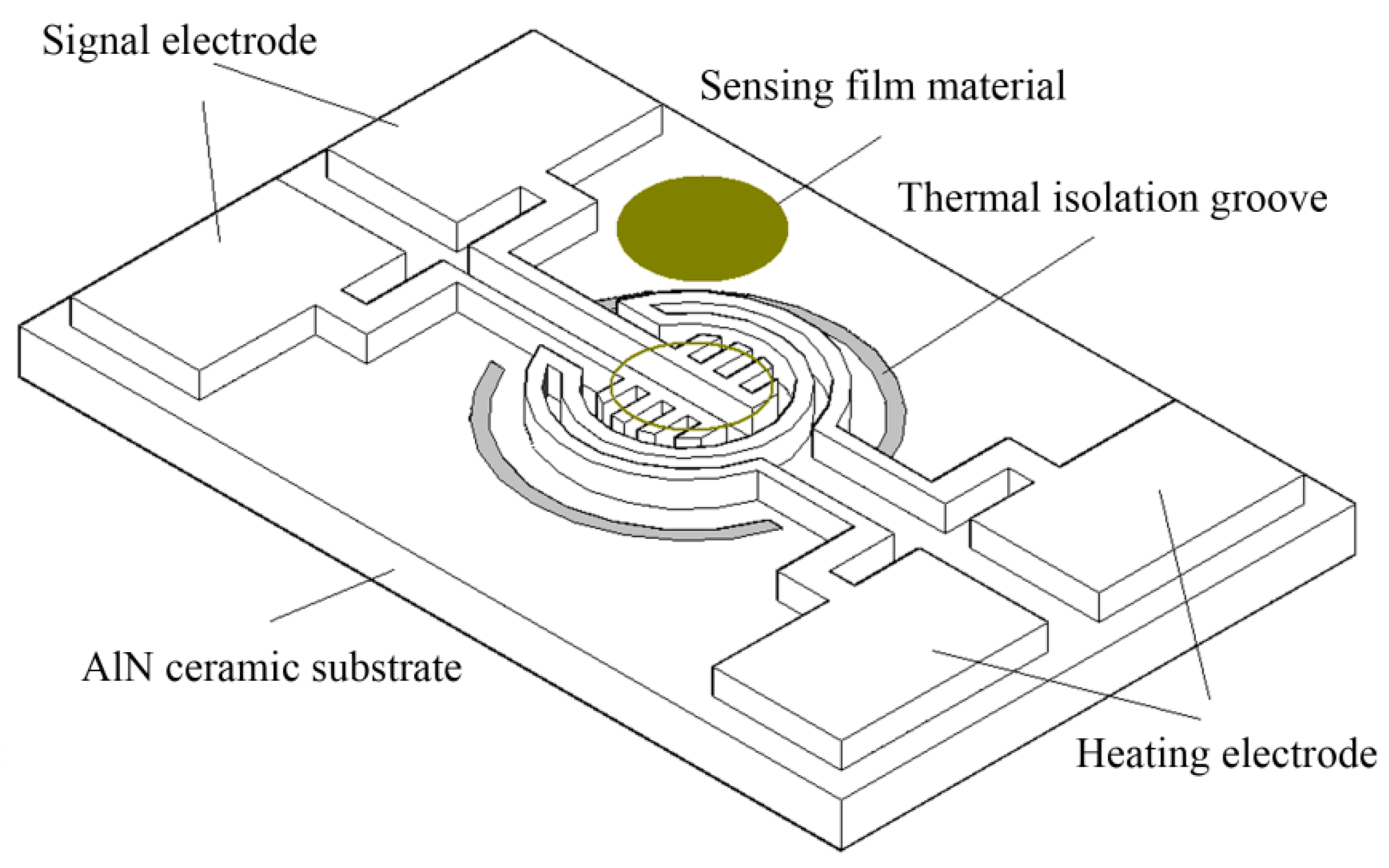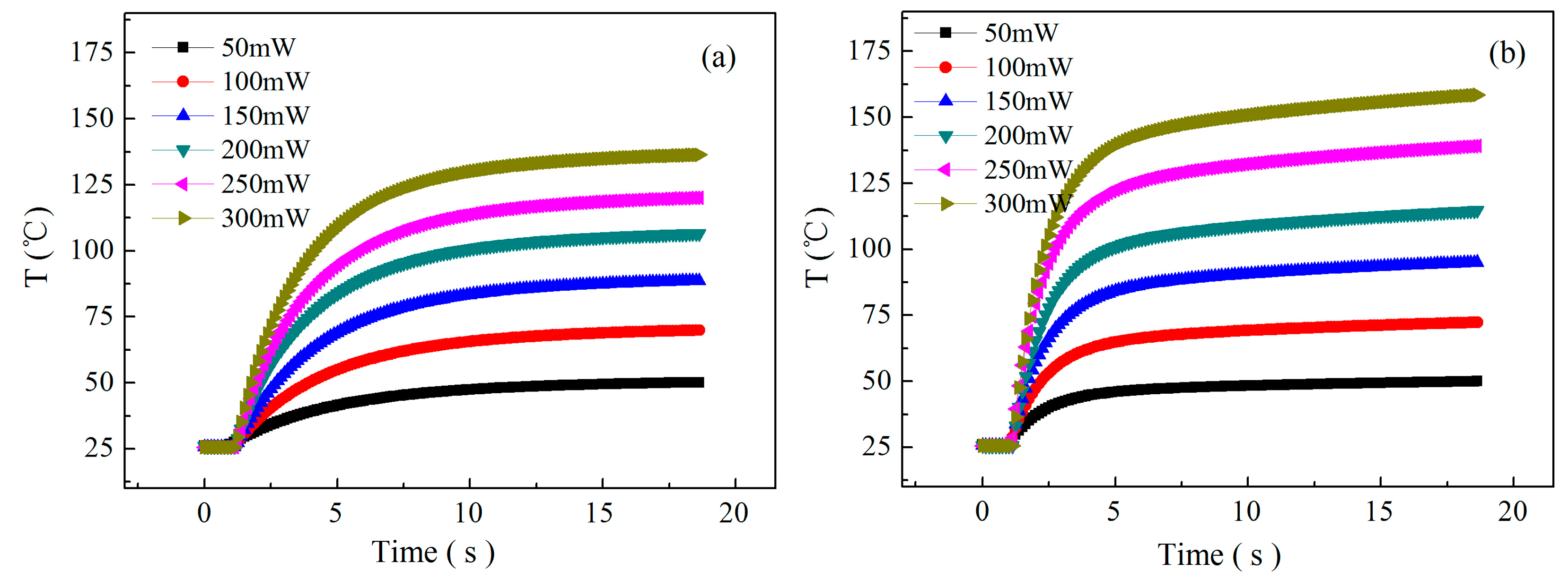A Low-Temperature Micro Hotplate Gas Sensor Based on AlN Ceramic for Effective Detection of Low Concentration NO2
Abstract
:1. Introduction
2. Thermal Structure Design and Simulation Analysis
2.1. Thermal Structure Design of Micro Hotplate Gas Sensor
2.2. Simulation Analysis of the Thermal Structure of a Micro Hotplate Sensor
3. Experimental
3.1. Synthesis and Characterization of Sensitive Materials
3.2. Fabrication of the Gas Sensor
4. Results and Discussion
4.1. Measurement of Thermal Response Characteristics
4.2. Gas Sensing Response Characteristics of Low Concentration NO2
4.3. Gas Sensing Response Characteristics of High Concentration NO2
5. Conclusions
Supplementary Materials
Author Contributions
Funding
Conflicts of Interest
References
- Zhang, C.; Luo, Y.; Xu, J.; Debliquy, M. Room Temperature Conductive Type Metal Oxide Semiconductor Gas Sensors for NO2 Detection. Sens. Actuators A Phys. 2019, 289, 118–133. [Google Scholar] [CrossRef]
- Mothe, G.; Castro, M.; Sthel, M.; Lima, G.; Brasil, L.; Campos, L.; Rocha, A.; Vargas, H. Detection of Greenhouse Gas Precursors from Diesel Engines Using Electrochemical and Photoacoustic Sensors. Sensors 2010, 10, 9726–9741. [Google Scholar] [CrossRef] [PubMed]
- Mengis, T.; Genty, F.; Aubert, T. Analysis of NO2 Absorption Cross-sections at High Temperature for the Development of Postcombustion Gases Optical Sensor. In Proceedings of the 2015 IEEE Workshop on Environmental, Energy and Structural Monitoring Systems (EESMS), Trento, Italy, 9–10 July 2015; pp. 141–145. [Google Scholar]
- Lin, C.; Gillespie, J.; Schuder, M.D.; Beverland, I.J.; Heal, M.R. Evaluation and Calibration of Aeroqual Series 500 Portable Gas Sensors for Accurate Measurement of Ambient Ozone and Nitrogen Dioxide. Atmos. Environ. 2015, 100, 111–116. [Google Scholar] [CrossRef]
- Zhang, F.; Shi, L.; Zhao, J.; Zheng, Y.; Xiao, Y.; Zheng, Y.; Jiang, L. Pyrochlore Pr2Zr2−xMxO7 (M = Al,Ga,In) Solid-state Electrolytes: Defect-mediated Oxygen Hopping Pathways and Enhanced NO2 Sensing Properties. Sens. Actuators B Chem. 2018, 270, 130–139. [Google Scholar] [CrossRef]
- Qi, W.; Li, W.; Sun, Y.; Guo, J.; Xie, D.; Cai, L.; Zhu, H.; Xiang, L.; Ren, T. Influence of Low-dimension Carbon-based Electrodes on the Performance of SnO2 Nanofiber Gas Sensors at Room Temperature. Nanotechnology 2019, 30, 345503. [Google Scholar] [CrossRef] [PubMed]
- Wang, Y.; Fan, S.-H.; Wang, S.-L. Chemiluminescence Determination of Nitrogen Oxide in Air with a Sequential Injection Method. Anal. Chim. ACTA 2005, 541, 131–136. [Google Scholar] [CrossRef]
- Lsiugo, K.; Newman, N.; Jandarov, R.; Grinshpun, S.A.; Reponen, T. Assessing the Accuracy of Commercially Available Gas Sensor for the Measurement of Ambient Ozone and Nitrogen dioxide. J. Occupa. Environ. Hyg. 2018, 15, 782–791. [Google Scholar]
- Malings, C.; Tanzer, R.; Hauryliuk, A.; Kumar, S.P.N.; Zimmerman, N.; Kara, L.B.; Presto, A.A.; Subramanian, R. Development of a General Calibration Model and Long-term Performance Evaluation of Low-cost Sensors for Air Pollutant Gas Monitoring. Atmos. Measure. Tech. 2019, 12, 903–920. [Google Scholar] [CrossRef]
- Zimmerman, N.; Presto, A.A.; Kumar, S.P.; Gu, J.; Hauryliuk, A.; Robinson, E.S.; Robinson, A.L.; Subramanian, R. A machine Learning Calibration Model Using Random Forests to Improve Sensor Performance for Lower-cost Air Quality Monitoring. Atmos. Measure. Tech. 2018, 11, 291–313. [Google Scholar] [CrossRef]
- Wang, Y.; Liu, C.; Wang, Z.; Song, Z.; Zhou, X.; Han, N.; Chen, Y. Sputtered SnO2: NiO Thin Films on Self-Assembled Au Nanoparticle Arrays for MEMS Compatible NO2 Gas Sensors. Sens. Actuators B Chem. 2019, 278, 28–38. [Google Scholar] [CrossRef]
- Liu, Y.; Liu, X.; Wang, Y.; Zhang, T. Metal-organic-framework-derived In2O3 Microcolumnar Sructures Embedded with Pt Nanoparticles for NO2 Detection Near Room Temperature. Ceram. Intern. 2019, 45, 9820–9828. [Google Scholar] [CrossRef]
- Akamatsu, T.; Itoh, T.; Izu, N.; Shin, W. NO and NO2 Sensing Properties of WO3 and Co3O4 Based Gas Sensors. Sensors 2013, 13, 12467–12481. [Google Scholar] [CrossRef] [PubMed]
- Xu, K.; Tian, S.; Zhu, J.; Yang, Y.; Shi, J.; Yu, T.; Yuan, C. High Selectivity of Sulfur-Doped SnO2 in NO2 Detection at Lower Operating Temperatures. Nanoscale 2018, 10, 20761–20771. [Google Scholar] [CrossRef] [PubMed]
- Ma, H.; Yu, L.; Yuan, X.; Li, Y.; Li, C.; Yin, M.; Fan, X. Room Temperature Photoelectric NO2 Gas Sensor Based on Direct Growth of Walnut-like In2O3 Nanostructures. J. Alloy. Comp. 2018, 782, 1121–1126. [Google Scholar] [CrossRef]
- You, R.; Han, D.-D.; Liu, F.M.; Zhang, Y.-L.; Lu, G.Y. Fabrication of Flexible Room-temperature NO2 Sensors by Direct Laser Writing of In2O3 and Grapheme Oxide Composites. Sens. Actuators B Chem. 2018, 277, 114–120. [Google Scholar] [CrossRef]
- Hu, Y.; Hu, X.; Qiu, J.; Quan, W.; Qin, W.; Min, X.; Lu, S.; Chen, S.; Du, W.; Chen, X. Nitric Oxide Detector Based on WO3-1wt% In2O3-1wt% Nb2O5 with State-of-the-Art Selectivity and ppb-Level Sensitivity. ACS Appl. Mater. Inter. 2018, 10, 42583–42592. [Google Scholar] [CrossRef] [PubMed]
- Xu, X.; Fan, H.; Liu, Y.; Wang, L.; Zhang, T. Au-loaded In2O3 Nanofibers-based Ethanol Micro Gas Sensor with Low Power Consumption. Sens. Actuators B Chem. 2011, 160, 713–719. [Google Scholar] [CrossRef]
- Zeng, W.; Liu, T.; Wang, Z. Impact of Nb Doping on Gas-sensing Performance of TiO2 Thick-film Sensors. Sens. Actuators B Chem. 2012, 166, 141–149. [Google Scholar] [CrossRef]
- Comini, E.; Ferroni, M.; Guidi, V.; Vomiero, A.; Merli, P.G.; Morandi, V.; Sacerdoti, M.; Mea, G.D.; Sberveglieri, G. Effects of Ta/Nb-doping on titania-based thin films for gas-sensing. Sens. Actuators B Chem. 2005, 108, 21–28. [Google Scholar] [CrossRef]
- Kruefu, V.; Liewhiran, C.; Wisitsoraat, A.; Phanichphant, S. Selectivity of Flame-spray-made Nb/ZnO Thick Films towards NO2 Gas. Sens. Actuators B Chem. 2011, 156, 360–367. [Google Scholar] [CrossRef]
- He, X.; Li, J.; Gao, X. Effect of V2O5 Coating on NO2 Sensing Properties of WO3 Thin Films. Sens. Actuators B Chem. 2005, 108, 207–210. [Google Scholar] [CrossRef]
- Jang, B.; Kim, W.; Song, M.-J.; Lee, W. Thermal Stability of the Sensing Properties in H2 Sensors Composed of Pd Nanogaps on an Elastomeric Substrate. Sens. Actuators B Chem. 2017, 240, 186–192. [Google Scholar] [CrossRef]
- Wiche, G.; Berns, A.; Steffes, H.; Obermeler, E. Thermal Analysis of Silicon Carbide Based Micro Hotplates for Metal Oxide Gas Sensors. Sens. Actuators A Phys. 2005, 123, 12–17. [Google Scholar] [CrossRef]
- Zhao, W.; Wang, X.; Wang, X. Thermal Interference Analysis of Ceramic Micro-plate Thermal-isolated Gas Sensor Arrays. Chin. J. Sci. Ins. 2016, 37, 579–585. [Google Scholar]
- Yu, J.; Tang, Z.; Huang, Z. Thermal Crosstalk of Micro Hotplate Arrays. J. Semi. 2008, 29, 1581–1584. [Google Scholar]
- Simon, I.; Barsan, N.; Bauer, M. Micro-machined Metal Oxide Gas Sensors: Opportunities to Improve Sensor Performance. Sens. Actuators B Chem. 2001, 73, 1–26. [Google Scholar] [CrossRef]
- Lalinsky, T.; Drzik, M.; Jakovenko, J.; Vanko, G.; Mozolova, Z.; Hascik, S.; Chlpik, J.; Hotovy, I.; Rehacek, V.; Kostic, I. GaAs Based Micro-machined Thermal Converter for Gas Sensors. Sens. Actuators A Phys. 2008, 142, 147–152. [Google Scholar] [CrossRef]
- Xu, P.; Cheng, Z.; Pan, Q.; Xu, J.; Xiang, Q.; Yu, W.; Chu, Y. High Aspect Ratio In2O3 Nanowires: Synthesis, Mechanism and NO2 Gas-sensing Properties. Sens. Actuators B Chem. 2008, 130, 802–808. [Google Scholar] [CrossRef]
- Inyawilert, K.; Channei, D.; Tamaekong, N.; Liewhiran, C.; Wisitsoraat, A.; Tuantranont, A.; Phanichphant, S. Pt-doped In2O3 Nanoparticles Prepared by Flame Spary Pyrolysis for NO2 Sensing. J. Nanopart. Res. 2016, 18, 40. [Google Scholar] [CrossRef]
- Zhao, J.; Yang, T.; Liu, Y.; Wang, Z.; Li, X.; Sun, Y.; Du, Y.; Li, Y.; Lu, G. Enhancement of NO2 Gas Sensing Response Based on Ordered Mesoporous Fe-doped In2O3. Sens. Actuators B Chem. 2014, 191, 806–812. [Google Scholar] [CrossRef]












| Materials | Operation Temperature (°C) | Concentration (ppm) | Response (Rg/Ra) | Response Time (s) | Recovery Time (min) | Reference |
|---|---|---|---|---|---|---|
| In2O3 nanowires | 250 | 1 | 2.57 | N/A | N/A | [29] |
| Pt-In2O3 | 250 | 5 | 1904 | 330 | 14 | [30] |
| Fe-In2O3 | 150 | 1 | 71 | 276 | 2.5 | [31] |
| Pt/In2O3 MCs | 40 | 1 | 44.9 | N/A | 7 | [12] |
| Pt/Nb/In2O3 | 94 | 1 | 2.87 | 180 | 10 | This work |
© 2019 by the authors. Licensee MDPI, Basel, Switzerland. This article is an open access article distributed under the terms and conditions of the Creative Commons Attribution (CC BY) license (http://creativecommons.org/licenses/by/4.0/).
Share and Cite
Zhao, W.-J.; Xu, D.; Chen, Y.-S.; Wang, X.; Shi, Y.-B. A Low-Temperature Micro Hotplate Gas Sensor Based on AlN Ceramic for Effective Detection of Low Concentration NO2. Sensors 2019, 19, 3719. https://doi.org/10.3390/s19173719
Zhao W-J, Xu D, Chen Y-S, Wang X, Shi Y-B. A Low-Temperature Micro Hotplate Gas Sensor Based on AlN Ceramic for Effective Detection of Low Concentration NO2. Sensors. 2019; 19(17):3719. https://doi.org/10.3390/s19173719
Chicago/Turabian StyleZhao, Wen-Jie, Dan Xu, Yin-Sheng Chen, Xuan Wang, and Yun-Bo Shi. 2019. "A Low-Temperature Micro Hotplate Gas Sensor Based on AlN Ceramic for Effective Detection of Low Concentration NO2" Sensors 19, no. 17: 3719. https://doi.org/10.3390/s19173719
APA StyleZhao, W.-J., Xu, D., Chen, Y.-S., Wang, X., & Shi, Y.-B. (2019). A Low-Temperature Micro Hotplate Gas Sensor Based on AlN Ceramic for Effective Detection of Low Concentration NO2. Sensors, 19(17), 3719. https://doi.org/10.3390/s19173719





